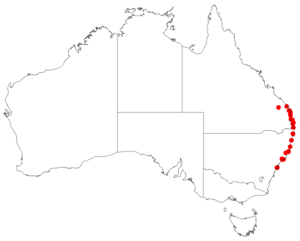Leucopogon deformis
| Leucopogon deformis | |
|---|---|
| Scientific classification | |
| Kingdom: | Plantae |
| Clade: | Tracheophytes |
| Clade: | Angiosperms |
| Clade: | Eudicots |
| Clade: | Asterids |
| Order: | Ericales |
| Family: | Ericaceae |
| Genus: | Leucopogon |
| Species: | L. deformis
|
| Binomial name | |
| Leucopogon deformis | |

| |
| Occurrence data from AVH | |
| Synonyms[1] | |
|
Styphelia deformis (R.Br.) Spreng. | |
Leucopogon deformis is a species of flowering plant in the heath family Ericaceae and is endemic to eastern coastal Australia. It is a bushy shrub with narrowly egg-shaped leaves, and white, tube-shaped flowers.
Description
Leucopogon deformis is a bushy shrub that typically grows to a height of less than 1 m (3 ft 3 in), its branchlets more or less glabrous. Its leaves are narrowly egg-shaped, 4.9–6.7 mm (0.19–0.26 in) long and 1.0–1.2 mm (0.039–0.047 in) wide on a petiole about 0.7 mm (0.028 in) long. The flowers are arranged on the ends of branches and in upper leaf axils and are sessile with bracteoles 1.3–1.7 mm (0.051–0.067 in) long. The sepals are 2.5–3.2 mm (0.098–0.126 in) long, the petals white and joined at the base to form a tube about 2 mm (0.079 in) long, the lobes 1.7–2.5 mm (0.067–0.098 in) long and softly-hairy inside. Flowering occurs from March to May and is followed by an oblong drupe 2.0–2.3 mm (0.079–0.091 in) long.[2]
Taxonomy and naming
Leucopogon deformis was first formally described in 1810 by Robert Brown in his Prodromus Florae Novae Hollandiae et Insulae Van Diemen.[3][4] The specific epithet (deformis) means "departing from the correct shape".[5]
Distribution and habitat
This leucopogon grows in coastal heath from Hawks Nest in New South Wales to south-east Queensland.[2][6]
References
- ^ a b "Leucopogon deformis". Australian Plant Census. Retrieved 5 August 2022.
- ^ a b Powell, Jocelyn M. "Leucopogon deformis". Royal Botanic Garden Sydney. Retrieved 5 August 2022.
- ^ "Leucopogon deformis". APNI. Retrieved 5 August 2022.
- ^ Brown, Robert (1810). Prodromus florae Novae Hollandiae et insulae Van-Diemen, exhibens characteres plantarum quas annis 1802-1805. London. p. 546. Retrieved 5 August 2022.
- ^ Sharr, Francis Aubi; George, Alex (2019). Western Australian Plant Names and Their Meanings (3rd ed.). Kardinya, WA: Four Gables Press. p. 180. ISBN 9780958034180.
- ^ Benson, Doug; McDougall, Lyn (1995). "Ecology of Sydney plant species Part 3: Dicotyledon families Cabombaceae to Eupomatiaceae". Cunninghamia. 4 (2): 367–368. Retrieved 5 August 2022.
Error: "Q17242055" is not a valid Wikidata entity ID.
- Articles with short description
- Articles with 'species' microformats
- Taxonbars desynced from Wikidata
- Taxonbar pages requiring a Wikidata item
- Taxonbars with invalid from parameters
- Taxonbars without secondary Wikidata taxon IDs
- Leucopogon
- Ericales of Australia
- Flora of Western Australia
- Plants described in 1810
- Taxa named by Jacques Labillardière